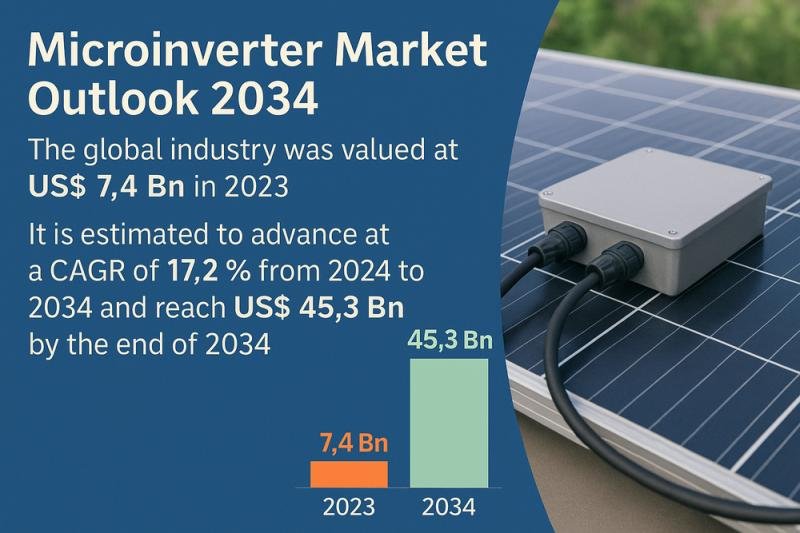The global microinverter market, valued at US$ 7.4 billion in 2023, is set to expand at a robust compound annual growth rate (CAGR) of 17.2% between 2024 and 2034, reaching an estimated US$ 45.3 billion by the end of 2034. Fueled by accelerating renewable energy adoption, supportive government policies targeting carbon emission reductions, and a rising demand for reliable, efficient power solutions, the market outlook remains exceptionally positive.
Market Overview: Microinverters are critical DC-to-AC converters mounted at the individual module level in solar photovoltaic (PV) systems. By independently managing each solar panel’s output, microinverters maximize energy harvest, improve system reliability, and simplify maintenance. The global microinverter market has witnessed significant traction as both residential rooftops and commercial installations increasingly prioritize module-level power electronics (MLPE) over centralized string inverters. The market’s rapid expansion is underpinned by advancements in smart microinverter designs, enabling plug-and-play installations, enhanced monitoring, and superior shading tolerance.
Access important conclusions and data points from our Report in this sample – https://www.transparencymarketresearch.com/sample/sample.php?flag=S&rep_id=86139
Market Drivers & Trends
Several key drivers are shaping the microinverter landscape:
Renewable Energy Adoption: The global pivot toward clean energy, led by surging solar capacity installations, directly fuels microinverter demand. Homeowners and businesses alike select microinverters to maximize panel-level performance and system uptime.
Government Initiatives: Legislative frameworks such as the U.S. Inflation Reduction Act, offering tax credits and incentives for solar deployments, and Southeast Asia’s targets of 35% renewable capacity by 2025, are accelerating microinverter uptake.
Energy Security & Decentralization: Concerns over grid reliability and the decentralization of energy generation boost interest in module-level solutions that can mitigate panel-specific faults without shutting down entire arrays.
Technological Innovation: Companies are embedding custom microchips and smart algorithms in next-gen microinverters to optimize size, weight, thermal management, and communication capabilities, enabling remote diagnostics and firmware updates.
Latest Market Trends
The microinverter market is witnessing several noteworthy trends:
Smart Plug-and-Play Solutions: Manufacturers are launching plug-and-play microinverters that reduce installation time and labor costs, making solar retrofits more accessible.
Integrated Storage Compatibility: Hybrid microinverters with built-in energy storage interfaces are emerging, allowing homeowners to pair PV generation seamlessly with batteries.
Wireless Communication Protocols: Wireless MLPE systems are gaining traction to simplify wiring and data collection, leveraging IoT platforms for real-time performance analytics.
Modular Scalability: Scalable architectures that let users add panels and microinverters incrementally are becoming popular, catering to phased installation budgets.
Key Players and Industry Leaders
The competitive landscape is anchored by innovators and established energy-tech firms:
Enphase Energy
SunSights Energy LLP
STMicroelectronics
Altenergy Power System Inc.
Hoymiles Power Electronics Inc.
Chilicon Power, LLC
AEconversion GmbH & Co. KG.
Envertech
ZJBENY
Bluesun Solar Co., Ltd.
Solar Panels Plus
Northern Electric Power Technology Inc.
Sparq Systems
Yotta Energy Inc.
Recent Developments
January 2024: Enphase Energy commenced shipments of its IQ8 Microinverters (IQ8HC and IQ8X), designed for streamlined pairing with modules up to 540 W DC and featuring built-in grid-forming capabilities to support black-start applications.
March 2023: APsystems forged a global distribution alliance with OSW, Australia’s premier solar distributor, to proliferate its multi-platform MLPE products across APAC, Europe, and North America.
Q1 2025: STMicroelectronics unveiled a new family of microinverter power stage ICs, boasting improved thermal efficiency and reduced bill-of-materials costs.
April 2025: Hoymiles introduced its wireless module-level monitoring solution, integrating Bluetooth Low Energy (BLE) for simplified commissioning and troubleshooting.
Market Opportunities
As the solar ecosystem evolves, several avenues for growth have emerged:
Emerging Economies: Underpenetrated markets in Latin America, Africa, and Southeast Asia offer high-potential entry points for microinverter providers, driven by rural electrification initiatives.
Bifacial and High-Power Panels: The rise of bifacial modules and panels exceeding 500 W DC necessitates advanced microinverters capable of handling increased currents and voltages.
Energy Trading Platforms: Integration with blockchain-enabled peer-to-peer energy trading platforms could enable prosumers to monetize excess generation at the module level.
Off-Grid & Hybrid Systems: Remote microgrid deployments in islands, mining operations, and telecom towers represent a lucrative niche for ruggedized, off-grid capable microinverters.
Future Outlook
The microinverter market is poised for sustained double-digit growth through 2034. Key forecasts include:
Revenue Growth: From US$ 7.4 Bn in 2023 to US$ 45.3 Bn in 2034 at 17.2% CAGR.
Unit Shipments: Expected to surpass 50 million microinverter units annually by 2030, driven by residential retrofits and new construction.
Technology Evolution: Shift from single-phase to three-phase microinverters for commercial and utility-scale installations.
Cost Reductions: Economies of scale and semiconductor integration will drive down per-unit costs, making microinverters more competitive with central inverter systems.
Analysts anticipate that increasing consumer awareness of long-term energy yield benefits, combined with falling hardware costs, will cement microinverters as the preferred MLPE solution across market segments.
Buy this Premium Research Report and unlock critical data and findings – https://www.transparencymarketresearch.com/checkout.php?rep_id=86139<ype=S
Market Segmentation
The global microinverter market can be segmented as follows:
By Type: Single Phase | Three Phase
By Power Rating: Below 250 W | 250 W-500 W | Above 500 W
By Communication: Wired | Wireless
By Application: Residential | Commercial | Industrial/Utility
Each segment presents unique growth dynamics. Residential installations dominate in volume, while commercial and utility applications are increasingly adopting three-phase, high-power microinverters to optimize large-scale PV farms.
Regional Insights
Asia Pacific: Leading region in 2023, buoyed by high solar adoption in China, India, Japan, and Southeast Asia. Rapid rooftop PV growth, combined with supportive policies, cements APAC’s top market share.
North America: Strong growth driven by the U.S. and Canada, underpinned by tax incentives, net-metering policies, and a surge in residential solar installations.
Europe: Stable demand in Germany, U.K., France, and Italy, with an increasing shift toward retrofit projects and hybrid storage-coupled microinverter systems.
Middle East & Africa: Emerging solar hubs like UAE, Saudi Arabia, and South Africa are beginning to embrace module-level electronics for distributed generation.
South America: Brazil, Chile, and Argentina are expected to see upticks in microinverter usage as rural electrification and net-metering schemes expand.
Why Buy This Report?
Organizations and stakeholders should procure this market report to gain:
In-Depth Analysis: Comprehensive coverage of market drivers, restraints, opportunities, and key trends.
Competitive Intelligence: Detailed profiles of leading microinverter manufacturers, technology innovators, and new entrants.
Forecast Accuracy: Quantitative projections through 2034, incorporating scenario analyses and sensitivity testing.
Strategic Insights: Actionable recommendations for product development, market entry, and regional expansion.
Data-Rich Appendices: Excel-based datasets for market sizing, segmentation, and company benchmarking.
This report equips decision-makers with the knowledge to navigate the evolving microinverter landscape, capitalize on emerging opportunities, and develop strategies that align with global decarbonization goals.
Explore Latest Research Reports by Transparency Market Research:
Magneto Elastic Torque Sensor Market: https://www.transparencymarketresearch.com/magneto-elastic-torque-sensor-market.html
Lab on Chips Market: https://www.transparencymarketresearch.com/lab-on-chips-market.html
Digital Substations Market: https://www.transparencymarketresearch.com/digital-substation-market.html
Atomic Force Microscopes (AFM) Market: https://www.transparencymarketresearch.com/atomic-force-microscopes-market.html
About Transparency Market Research
Transparency Market Research, a global market research company registered at Wilmington, Delaware, United States, provides custom research and consulting services. Our exclusive blend of quantitative forecasting and trends analysis provides forward-looking insights for thousands of decision makers. Our experienced team of Analysts, Researchers, and Consultants use proprietary data sources and various tools & techniques to gather and analyses information.
Our data repository is continuously updated and revised by a team of research experts, so that it always reflects the latest trends and information. With a broad research and analysis capability, Transparency Market Research employs rigorous primary and secondary research techniques in developing distinctive data sets and research material for business reports.
Contact:
Transparency Market Research Inc.
CORPORATE HEADQUARTER DOWNTOWN,
1000 N. West Street,
Suite 1200, Wilmington, Delaware 19801 USA
Tel: +1-518-618-1030
USA – Canada Toll Free: 866-552-3453
Website: https://www.transparencymarketresearch.com
Email: sales@transparencymarketresearch.com
This release was published on openPR.















